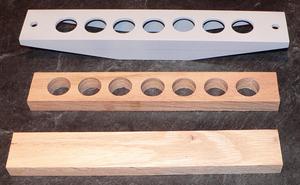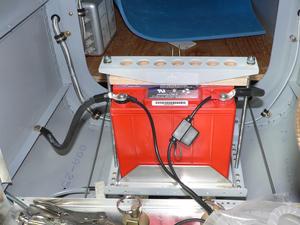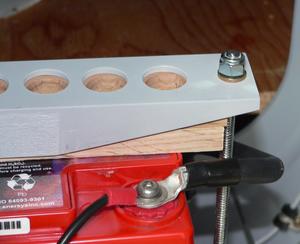The battery tray was designed for a much larger battery than I will be using. I've got a standby alternator, so I only really need a battery that is big enough to start the engine. The stock design battery tray needed some modifications to be compatible with my smaller battery.
 The basic tray has a U-shaped channel that sits on top of the battery, with bolts to hold it down. The flat side of the U goes down, with the two ends of the channel pointing upwards. My battery is quite a bit narrower, so the terminals would be close to the U-channel, and there was some risk that the terminals could short out against the channel if the battery moved a bit.
The basic tray has a U-shaped channel that sits on top of the battery, with bolts to hold it down. The flat side of the U goes down, with the two ends of the channel pointing upwards. My battery is quite a bit narrower, so the terminals would be close to the U-channel, and there was some risk that the terminals could short out against the channel if the battery moved a bit.
I decided to turn the channel over, so the flat side was on the top, and then trim the channel at an angle to make more clearance with the terminals. Putting the flat side up would have the channel only touching the battery on the edges, which would put a lot of pressure on a very small area. I trimmed some pieces of hard wood to fit inside the channel, to spread the load over a large area. The wood is non-conductive, so there is no risk of it shorting out the terminals.
 At the bottom of the battery, you can see one of the pieces of angle I bolted to the battery tray to make it fit my much narrower battery. This is a small gap at the end of the battery that I need to fill with another piece of hard wood.
At the bottom of the battery, you can see one of the pieces of angle I bolted to the battery tray to make it fit my much narrower battery. This is a small gap at the end of the battery that I need to fill with another piece of hard wood.
 The bolts that came with the kit were a bit too short, due to the fact that I had turned the U-channels over to put the flat side on the top. I couldn't find longer bolts easily, so I used some threaded rod, and then applied some high strength LockTite to permanently attach some nuts to the top end.
The bolts that came with the kit were a bit too short, due to the fact that I had turned the U-channels over to put the flat side on the top. I couldn't find longer bolts easily, so I used some threaded rod, and then applied some high strength LockTite to permanently attach some nuts to the top end.
The positive battery cable is about an inch away from the threaded rob, but there is some risk that it could move and chafe against the threads. I need to put a piece of rubber hose over the threaded rod to guard against that. One more thing for the snag list.